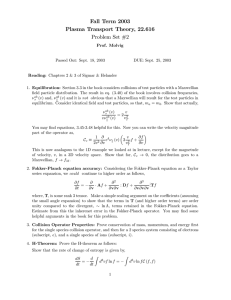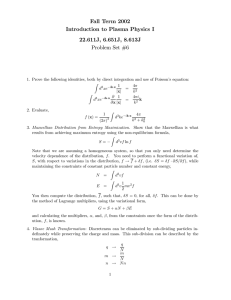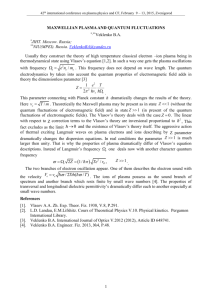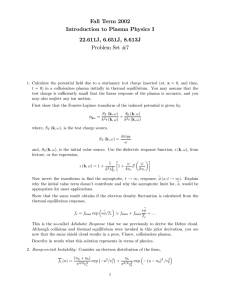Document 13608230
advertisement
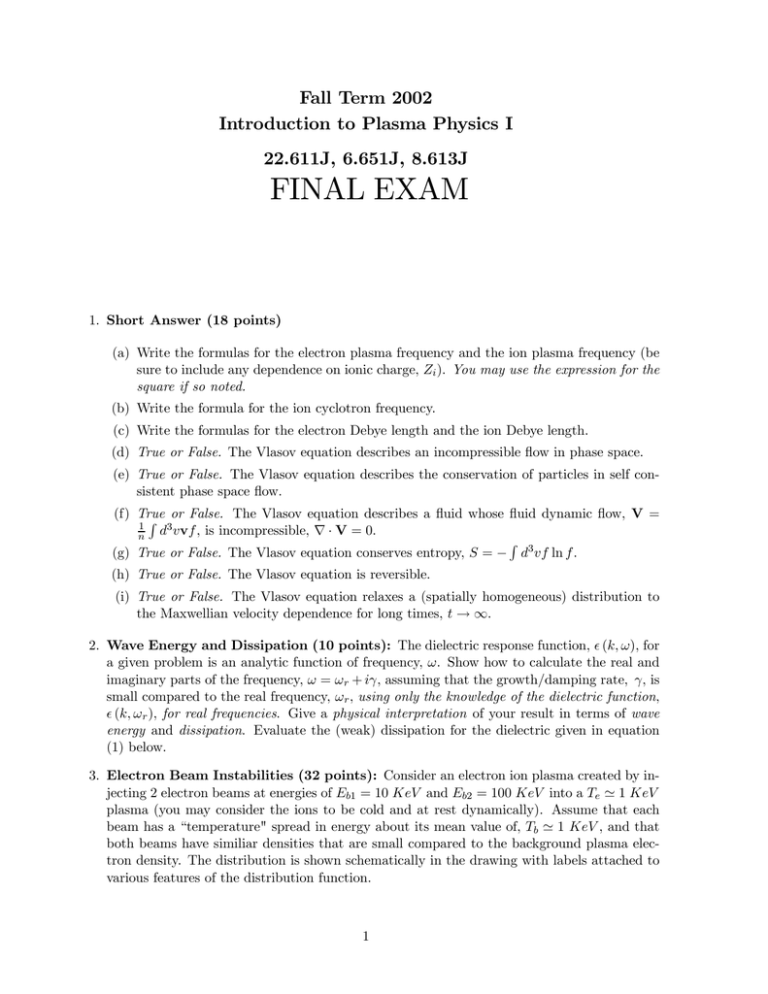
Fall Term 2002 Introduction to Plasma Physics I 22.611J, 6.651J, 8.613J FINAL EXAM 1. Short Answer (18 points) (a) Write the formulas for the electron plasma frequency and the ion plasma frequency (be sure to include any dependence on ionic charge, Zi ). You may use the expression for the square if so noted. (b) Write the formula for the ion cyclotron frequency. (c) Write the formulas for the electron Debye length and the ion Debye length. (d) True or False. The Vlasov equation describes an incompressible flow in phase space. (e) True or False. The Vlasov equation describes the conservation of particles in self consistent phase space flow. (f) TrRue or False. The Vlasov equation describes a fluid whose fluid dynamic flow, V = 1 d3 vvf , is incompressible, ∇ · V = 0. n R (g) True or False. The Vlasov equation conserves entropy, S = − d3 vf ln f . (h) True or False. The Vlasov equation is reversible. (i) True or False. The Vlasov equation relaxes a (spatially homogeneous) distribution to the Maxwellian velocity dependence for long times, t → ∞. 2. Wave Energy and Dissipation (10 points): The dielectric response function, (k, ω), for a given problem is an analytic function of frequency, ω. Show how to calculate the real and imaginary parts of the frequency, ω = ω r + iγ, assuming that the growth/damping rate, γ, is small compared to the real frequency, ω r , using only the knowledge of the dielectric function, (k, ωr ), for real frequencies. Give a physical interpretation of your result in terms of wave energy and dissipation. Evaluate the (weak) dissipation for the dielectric given in equation (1) below. 3. Electron Beam Instabilities (32 points): Consider an electron ion plasma created by injecting 2 electron beams at energies of Eb1 = 10 KeV and Eb2 = 100 KeV into a Te ' 1 KeV plasma (you may consider the ions to be cold and at rest dynamically). Assume that each beam has a “temperature" spread in energy about its mean value of, Tb ' 1 KeV , and that both beams have similiar densities that are small compared to the background plasma electron density. The distribution is shown schematically in the drawing with labels attached to various features of the distribution function. 1 Evaluate the labels, ve , vb , Ub1 , Ub2 shown on the drawing and indicate which quantities, if any, are equal. You may take, vm1 = Ub1 − αvb , and, vm2 = Ub2 − αvb , where the quantity, α, can be treated as an order unity constant for the calculations below (and if you have time after the rest of exam is done, you can evaluate, α, to get a perfect score on this portion of exam!). You may assume positive wavenumber, k, throughout. Indicate any phase velocity range (or ranges) where unstable waves exist. Write down any inequalities that characterize these modes (i.e. relations such as, ω/k À vb , although this particular relation may not be relevant). Calculate the (dimensionless) wave energy and growth rate of the most unstable mode in each band (you may assume weak dissipation). Leading order calculations are acceptable in all cases. Recall that the dielectric response function is given by, Z ω 2pe 1 dF (k, ω) = 1 − 2 du k u − ω/k du L Z 1 = du F (u) (1) Which mode dominates for long times in the linear regime? 4. Ion Acoustic Waves (15 points): Start from the collisionless dielectric function for an electron-ion plasma in thermal equilibrium, µ µ · ¶¸ · ¶¸ ω ω 1 ω 1 ω Z Z (k, ω) = 1 + 2 2 1 + + 2 2 1+ kvi kvi kve kve k λi k λe Z 2 1 e−t Z (ζ) ≡ √ dt π L t−ζ 2 p p where, λi , λe , vi = 2Ti /mi , ve = 2Te /me , are the usual Debye lengths and thermal velocities, and show that for waves in the range, vi ¿ ω/k ¿ ve , the reactive dielectric response can be written, ω2pi 1 (k, ω) ' 1 + − R ω2 k 2 λ2e Then show that for long wavelength waves, k2 λ2e ¿ 1, this leads to the ion acoustic dispersion relation, ω 2 ' k 2 c2s with, c2s = Te /mi . Show that these wave are quasineutral (for, k 2 λ2e ¿ 1). 5. Ion-electron collisions (10 points): The energy exchange portion of the electron-ion collision operator can be written, for Maxwellian ions, as, ¸ · me 3 1 ∂ Ti ∂ 1 ∂ E + fe (fe ) = ν ei ve 2 (2) Cei 2mi v ∂v me v2 ∂v v ∂v R The energy moment, d3 v 12 me v 2 , of this operator, for Maxwellian electrons, gives, r me 2 −ν ei n (Te − Ti ) mi π Now consider the ion-electron collision operator, Cie (fi , fe ). Use a fundamental property of collision operator to write down or derive an expression for the energy moment, R the d3 v 12 mi v2 , of the ion-electron collision operator, Cie (fi , fe ), assuming Maxwellian distributions for both ions and electrons. State explicitly the collision operator property that you used and discuss the physical implications of the result you have derived. 6. Thermal Equilibrium (15 points): (a) (5 points) Show that the Maxwellian velocity distribution is the result of maximizing the entropy, Z S = − d3 vf ln f R to the constraints of fixed particle number, n = d3 vf , and fixed energy, E = Rsubject d3 v 12 mv 2 f . R (b) (5 points) What is the effect on the entropy, S = − d3 vf ln f , when the distribution evolves according to, ∂f = C (f, f ) ∂t where the Coulomb collision operator is given by, µ ¶ Z ¡ 0¢ ∂ ∂ ∂ 0 3 0 C (f, f ) = Γ · d v U(v − v ) · − f (v) f v ∂v ∂v ∂ v0 with, 0 U(v − v ) = Γ = µ ¶ (v − v0 ) (v − v0 ) I− |v − v0 |2 2πq 4 ln Λ m2 1 |v − v0 | 3 E (f ), given by equation (c) (5 points) Show that, with the energy collision operator, Cei e (2), the steady state solution to, ∂fe E = Cei (fe ) ∂t is given uniquely by, ¶ µ 1 2 fe (v) = const. × exp − me v /Ti 2 Discuss in physical terms the two processes described by equation (2) that balance to give this thermal equilibrium state. 4
